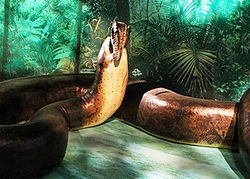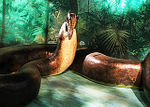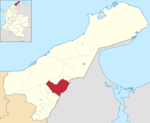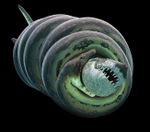Titanoboa
| Titanoboa |
|---|

|
| Scientific Classification |
| Scientific Name |
|
Titanoboa cerrejonensis |
The Titanoboa is the largest snake known to man and was the largest animal in the world at one point. This snake was found on a coal mine in the Cerrejon region of Columbia. This snake was fifty feet long and two thousand pounds and had a jaw that could open a hundred and eighty degrees and could eat more than its own weight in food. This snake doesn't hunt like a normal constrictor but because of its size and weight, it has to use gravity in order to slide its prey down its throat. this snake like many others has a mating season but before that the males stay away from the females out of fear of being eaten.
Body Design
The Titanoboa is a prehistoric snake that was found to be the largest snake every recorded at a length of 50 feet and a weight of 2,000 pounds. This snake is believed to be a hybrid of a anaconda and boa by scientists. when this snake was alive it would have lived like many Anaconda's and Boa's do, in bodies of water and warming itself in the sun on land. Many people wonder how this snake grew to this size and length without being hunted down by other predators or without being seen by people but many scientist think it was the warm climate that allowed the snake to grow this large and that the cooling temperatures or this era is why we don't see these massive snakes anymore. these snakes spent most of their life in water and taking that into account the color of the snake would have been changed dramatically. the green and brown murky water would have changed the snakes skin as a form of camouflage and make it easier to hunt. this snakes fossils were found on a coal mine, as well as pieces jaw bone, which is rare for how fragile snakes bones are, these jaw pieces showed scientists the this snakes jaw could have opened at least a hundred and eighty degrees which would make it more than capable to swallow a crocodile. this snake was so strong that it could squeeze its prey at about four hundred pounds per square inch which is the equivalent to three Eiffel Towers on top of one another.[2]
Life Cycle
Titanoboa was the largest snake at this time but that doesn't mean there weren't more than one of these snakes. these animals much like all others had a mating season with was around springtime and normally the males would never go near a female out of the fear that they would eat them but once a year for two days the females let out this hormone that alert the mates its mating season and after that the males are fighting to find a female. the males compete by coiling around the females and try to wrestle the other males off until there is only one and that one will fertilize the eggs. right after this happens the females will instantly attack the male and eat them for one last meal before resting the next seven months of pregnancy. after these seven months of rest and hiding the baby's are born ready for the world and break through a thin membrane and come out a three feet long baby Titanoboa and already fifty pounds and swim away right after looking for their first hunt and are ready to protect themselves and their first trial will be to get away from their mother who will try to eat them as her first meal, there will be hundreds of baby's but only a third of them will live after birth.[3]
Titanoboa were constrictors which means they squeeze their prey so hey can't breathe. They are not venomous and can strike with incredible speed and accuracy and can swallow more then their own body weight. They are so big that they cant just slide their prey in their mouths, but when they catch their prey they tilt their head bath in the air and move their head up and down and use gravity to slide their prey down their throat.[4]
Ecology
Titanoboa was found In the lowland tropics of northern Colombia, 60 miles from the Caribbean coast in the Cerrejón region in 2007. They are assumed to have lived in the murky water of the amazon and to have spent most of its life. In the water but being cold blooded they occasionally came on land to sun bath and hunt. these reptiles would eat whatever they could catch such as crocodiles, turtles, monkeys, even other boas these, snakes were carnivorous however so they didn't eat anything that wasn't meat. Scientists believe that their environment had a huge contribution to how big these snakes got, in this time the cerrejón region was way hotter than it is now and scientists believe that due to the drop in temperature that it is likely we still have snakes like this, but not impossible, there are many reports of giant snakes in the amazon even before this snake was found and continue to pop up along the amazon even today.[5]
Hunting
This snake looked like a boa but it hunted like a crocodile, just by looking at this snake u would think that it would hunt by squeezing its prey until it they suffocate but this snake would use its speed and accuracy to attack its pray and just like a crocodile it would slowly glide next to its prey half submerged in the water and then when the time was right it would lunge out with one huge leap and trap its preys windpipe in its jaws.[6]
Video
Titanoboa boa discovery
References
- ↑ Titano boa (https://en.wikipedia.org/wiki/Titanoboa) Wikipedia. web. last modified 22 January 2017, author unknown.
- ↑ Joshi, Monika. Titanoboa once slithered the planet USA TODAY. Web. Updated march 30, 2012.
- ↑ Mating habits Titanoboa cerrejonesis. web. accessed January 29, 2017,author unknown.
- ↑ Titanoboa Snake Facts. web. accessed January 29. 2017 author unknown.
- ↑ Titanoboa-The-Worlds-Largest-Snake-Ever Owlcation. web. Updated on December 27, 2016 author unknown.
- ↑ 5 Amazing Facts About Titanoboa The Mystic Facts. Web. Accessed January 29, 2017. Author unknown




